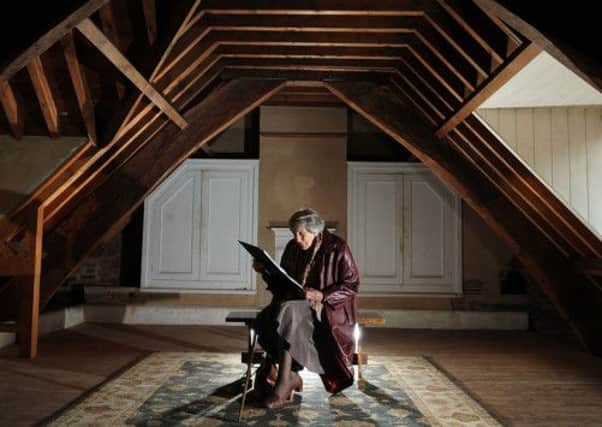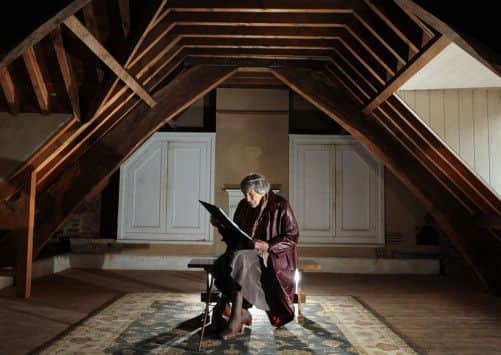Video: Susanna, 89, goes back to her old nursery


Nor have the memories of Susanna Richmond, who yesterday returned to Mount Grace Priory in North Yorkshire to see the nursery where she and her cousins spent their childhood in the early 1920s.
Now aged 89 – and adamant she has shrunk by at least two inches since her last measurement was inscribed – she still recalls her time there vividly, including encounters with royalty.
Advertisement
Hide AdAdvertisement
Hide Ad“Queen Mary came to visit quite regularly,” said Mrs Richmond, the great-granddaughter of wealthy steel magnate and MP Sir Isaac Lowthian Bell, who bought the house in 1898.


“We were all taught to curtsy to her but, being a difficult child, I refused.
“Upon this, Queen Mary took me by the hand and walked around the entire Mount Grace site with me.”
The attics of the manor in Staddlebridge, Northallerton, were used as a nursery by the Bell family during the 1920s and 1930s and Mrs Richmond – then known as Nora – spent many hours playing there with her cousins Hugh and John.
Advertisement
Hide AdAdvertisement
Hide AdNow they have been opened to the public for the first time by English Heritage, which manages the 14th century monastary site.
“It was a huge playground when we were little but now I feel all these other feelings about it,” said Mrs Richmond.
“It’s a very historic place, it’s a very spiritual place actually, although not having the sense when I was little I didn’t feel that so much.
“But it was a nice place to stay and gave you space to play and run around.
“Now I think it’s still a quite powerful place.”
Advertisement
Hide AdAdvertisement
Hide AdMark Douglas, buildings curator for English Heritage in the north, said the newly-opened rooms would also give visitors a sense of the manor’s social history, which Mrs Richmond had helped to bring to life.
“She is the last link we have with the Bell family and that period of the house when it was lived in by them,” he said.
“It is that tangible link with the past that she has which we can tap into, so it is always a pleasure to have her round. It is a great honour, really.”
Site manager Barbara Owen added: “We’re absolutely thrilled to have Susanna visit and share her stories of her time at Mount Grace Priory.
Advertisement
Hide AdAdvertisement
Hide Ad“The attics are an important part of the building, and the names on the wall marking the children’s height really bring the space to life and remind us of what this house must have been like when it was once a family home.”
The rooms also give a glimpse of the architectural details of the roof and a prime vantage point from which to view the priory ruins and gardens.
“It adds a new dimension to Mount Grace,” said Ms Owen.
English Heritage is now conducting more research into the rooms to discover how else they have been used over the centuries.
Founded in 1398, the priory was one of ten medieval Carthusian houses in England, whose monks led hermit-like lives of solitude and piety.
Advertisement
Hide AdAdvertisement
Hide AdThe manor, which was used as a guest house for visiting dignitaries, later became a gentleman’s residence after the monastary was closed in 1539 by Henry VIII .
In 1653 it was bought by Thomas Lascelles, who converted the ruined guest house range into a small manor house and added two new wings using stones taken from the monastic buildings.
But by the 19th century it had fallen into disrepair again and faced a bleak future until it was rescued by Sir Isaac, one of Britain’s foremost industrialists who had made his fortune in the steel industry.
An advocate of the Arts and Crafts design movement and a passionate buildings conservationist, he was persuaded by the Society for the Protection of Ancient Buildings to buy the site.
Advertisement
Hide AdAdvertisement
Hide AdAs he lovingly restored and extended the manor, Sir Isaac preserved both its monastic and Commonwealth features, while adding his own Arts and Crafts stamp, including square black leaded windows, which are still visible today.
The Bell family gave up the estate to the Government in 1953 in lieu of hefty death duties after Mrs Richmond’s uncle Sir Maurice Bell passed away.
Today the site, which is now owned by the National Trust and managed by English Heritage, is treasured as the best preserved Carthusian priory in Britain.
“Lowthian Bell saved the whole site for the nation,” said Mr Douglas. “If it hadn’t been for him we don’t know what might have happened to it.
“He made a massive contribution to the heritage of the country and certainly for Yorkshire.”